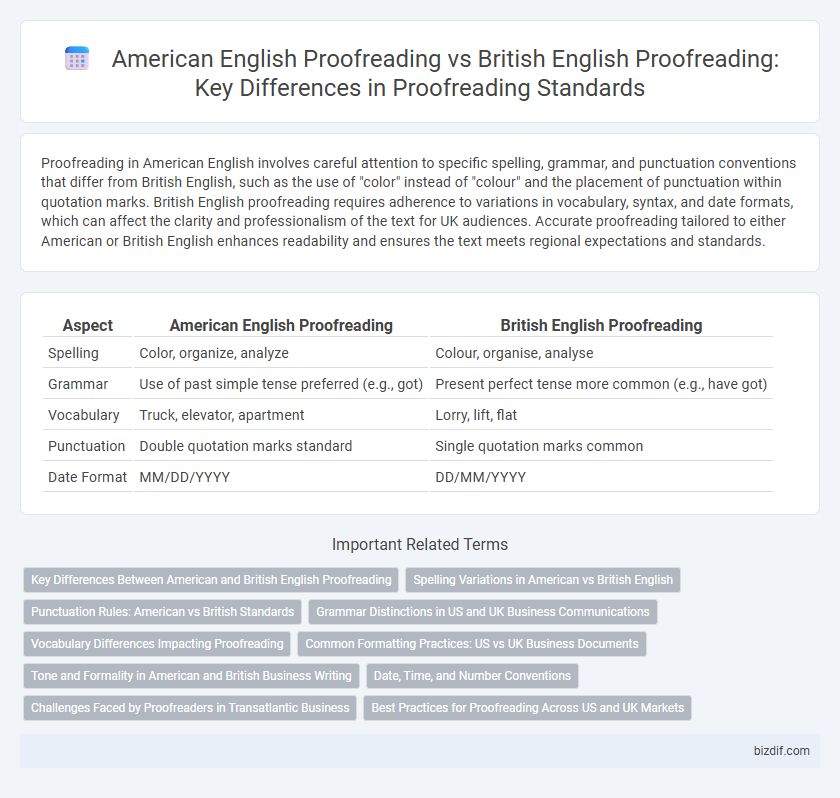Proofreading in American English involves careful attention to specific spelling, grammar, and punctuation conventions that differ from British English, such as the use of "color" instead of "colour" and the placement of punctuation within quotation marks. British English proofreading requires adherence to variations in vocabulary, syntax, and date formats, which can affect the clarity and professionalism of the text for UK audiences. Accurate proofreading tailored to either American or British English enhances readability and ensures the text meets regional expectations and standards.
Table of Comparison
| Aspect | American English Proofreading | British English Proofreading |
|---|---|---|
| Spelling | Color, organize, analyze | Colour, organise, analyse |
| Grammar | Use of past simple tense preferred (e.g., got) | Present perfect tense more common (e.g., have got) |
| Vocabulary | Truck, elevator, apartment | Lorry, lift, flat |
| Punctuation | Double quotation marks standard | Single quotation marks common |
| Date Format | MM/DD/YYYY | DD/MM/YYYY |
Key Differences Between American and British English Proofreading
American English proofreading emphasizes spelling variations such as "color" versus "colour" and punctuation customs like placing periods and commas inside quotation marks. British English proofreading often requires checking for different vocabulary usage, for instance, "lorry" instead of "truck," and unique punctuation rules, including the placement of punctuation outside quotation marks in certain cases. Both styles demand attention to grammar differences, such as collective noun agreement, where British English might treat a collective noun as plural, unlike American English.
Spelling Variations in American vs British English
American English proofreading emphasizes spelling variations such as "color" instead of the British "colour" and "organize" versus "organise." Paying close attention to these differences ensures consistency and accuracy in written documents, avoiding confusion for the target audience. Proper proofreading also includes recognizing unique orthographic patterns like "theater" (American) compared to "theatre" (British).
Punctuation Rules: American vs British Standards
American English proofreading typically follows the placement of periods and commas inside quotation marks regardless of logic, while British English places these punctuation marks outside unless they are part of the quoted material. The use of the Oxford comma also varies, with American English favoring its consistent application for clarity, and British English generally omitting it unless needed for disambiguation. Differences in punctuation rules impact clarity and reader expectations, making it essential to align proofreading with the targeted dialect for accuracy and professionalism.
Grammar Distinctions in US and UK Business Communications
American English proofreading emphasizes grammar rules such as the use of the serial comma and simpler past tense forms, while British English proofreading tends to follow traditional conventions like omitting the Oxford comma and using the present perfect tense more frequently. In US business communications, grammar typically favors directness and clarity with consistent verb agreement and punctuation rules, whereas UK business writing often adheres to more formal structures and nuanced verb usage. Recognizing these grammar distinctions is crucial for effective proofreading to ensure that business documents align with regional standards and convey professionalism.
Vocabulary Differences Impacting Proofreading
Vocabulary differences between American English and British English significantly influence proofreading processes, necessitating careful attention to regional word usage such as "color" versus "colour" and "organize" versus "organise." Proofreaders must be vigilant in identifying these variations to maintain consistency and ensure the text aligns with the target audience's linguistic preferences. Failure to address these vocabulary distinctions can result in reduced clarity and perceived inaccuracies in the final document.
Common Formatting Practices: US vs UK Business Documents
In American English proofreading, common formatting practices for business documents emphasize the use of the American date format (MM/DD/YYYY) and the placement of punctuation within quotation marks, differing from British English standards, which prefer the DD/MM/YYYY format and punctuation placement outside quotes unless part of the original speech. US business documents typically feature a block format with left-aligned text and single spacing, while UK documents often use indented paragraphs and may employ double spacing between sections. Understanding these distinctions is crucial for accurate proofreading to ensure clarity, professionalism, and regional appropriateness in business communication.
Tone and Formality in American and British Business Writing
American English proofreading often emphasizes a direct and conversational tone, reflecting a preference for clarity and approachability in business writing. British English proofreading typically maintains a more formal and polite tone, with nuanced language that respects traditional etiquette and hierarchy. Understanding these tonal and formality differences ensures that business documents resonate appropriately with their intended audience in either American or British contexts.
Date, Time, and Number Conventions
American English proofreading requires formatting dates as month/day/year, using a 12-hour clock with AM/PM for time, and applying commas in numbers for thousands separators (e.g., 1,000). British English proofreading follows the day/month/year date format, often uses the 24-hour clock for time notation, and employs spaces or periods in large numbers instead of commas (e.g., 1 000 or 1.000). Accurate proofreading in these English variants ensures consistency and clarity in documents tailored to either American or British audiences.
Challenges Faced by Proofreaders in Transatlantic Business
Proofreaders working on transatlantic business documents face significant challenges due to differences between American English and British English spelling, grammar, and punctuation conventions. Variations such as "color" vs. "colour," "organize" vs. "organise," and differing use of commas and quotation marks require meticulous attention to ensure consistency and accuracy. Misinterpretation of idiomatic expressions and localized terminology further complicates the proofreading process, demanding a thorough understanding of both language variants to maintain professionalism and clarity in cross-border communications.
Best Practices for Proofreading Across US and UK Markets
Effective proofreading across US and UK markets requires thorough knowledge of regional spelling differences, such as "color" versus "colour," and distinct grammar rules, like collective nouns usage. Utilizing specialized style guides including The Chicago Manual of Style for American English and The Oxford Style Manual for British English ensures consistency and accuracy. Careful attention to punctuation conventions, date formats, and vocabulary variations further optimizes proofreading for international audiences.
American English proofreading vs British English proofreading Infographic

 bizdif.com
bizdif.com